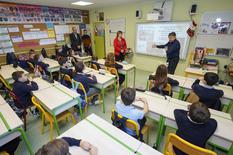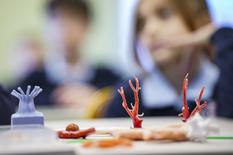- Homepage
- The Environment
- Actualités
- The Monaco Scientific Centre raises awareness in Year 6 pupils about preserving Mediterranean red coral
The Monaco Scientific Centre raises awareness in Year 6 pupils about preserving Mediterranean red coral
Since the start of the school year, the Monaco Scientific Centre (CSM) has been working with around ten Year 6 classes to raise awareness among young people of the need to preserve the Red Coral. At the end of these specially created workshops, organised in collaboration with the Department of Education, Youth and Sport, the CSM will be offering each pupil a copy of the book 'The Mysteries of the Red Coral'.
This initiative is designed to encourage pupils' curiosity and develop their observation and critical thinking skills while inspiring an interest in science and promoting a scientific culture at school. These are just some of the aims of the project, which targets Year 6 pupils in the Principality's primary schools.
As part of this project, three CSM researchers - Dr Romie Tignat-Perrier, Prof Denis Allemand and doctoral student Clémence Forin - have been presenting their work on red coral (also known as precious coral), an emblematic species of the Mediterranean, to the Principality's various Year 6 classes since the start of the school year. Through projections and samples, these three researchers encourage pupils to think about marine animal life and the need to protect it. At the end of the session, the book entitled 'The Mystery of the Red Coral', which CSM researchers were responsible for producing was presented to the students. This book, published by Éditions de La Martinière, is the result of a collaboration with the famous Chanel fashion house as part of the 'Raising Awareness' section of the CSM - Chanel Precious Coral Biology Research Unit programme.
Launched in 2019 for a 6-year period, this scientific programme aims to gain a better understanding of the growth and colour mechanisms of Mediterranean red coral and to study innovative solutions to help conserve this species. The goal is to gain a better understanding in order to provide better protection. The results of the research will be made available to all interested stakeholders through publications. This programme is divided into three sectors: a fundamental sector, an applied sector and an awareness and communication sector. This is the framework for this educational programme.
In her foreword to 'The Mystery of the Red Coral', H.R.H. The Princess of Hanover notes that this publication, created in the centenary year of the birth of Prince Rainier III, is a fitting tribute to her father since, among his many efforts to protect nature, he founded the Spélugues coral reef marine reserve, which protects the only coral reef in the Principality. Prince Rainier III also founded the Monaco Scientific Centre on 23 May 1960.
Discover more...
Precious and Red Corals
The term 'precious coral' refers to marine animals whose skeletons are used in jewellery. The best-known and most emblematic is the Mediterranean red coral, Corallium rubrum. Often referred to as 'Red Gold' or 'Blood of Christ', it has a high market value and is also valued as a good luck charm and a protector against spirits. It is even said that a concoction made from crushed red coral and honey can 'regenerate' the blood and improve male stamina! Still to this day, its properties are recognised in homeopathy. But it’s the use in secular and religious art that makes it so valuable: sculpture, inlays, jewellery, etc. Often confused with the tropical corals that make up coral reefs and which have a white skeleton, red coral is very different, it has a red skeleton, which makes it so precious. As a result, it has been used since prehistoric times and has always been the subject of major trade, and even as a form of currency.
Historically, red coral was the first organism to be named 'coral'. Despite being used and traded for thousands of years, the true nature of red coral has long remained a mystery. For a long time, coral was considered to be a mineral (stone), a plant or an animal. Mediterranean red coral acquired its animal status definitively in the middle of the 18th century, thanks to a doctor from Marseille, Dr Jean-André Peyssonnel, after a bitter debate with René-Antoine Ferchault de Réaumur, the Director of the Royal Academy of Sciences at the time. It wasn't until over a century later that the first detailed biological study of red coral was published by the biologist Henri de Lacaze-Duthiers (1864), in a remarkable work entitled 'Histoire naturelle du corail'. Even today, red coral holds many mysteries.
A biological process at work: Biomineralisation
In jewellery, the axial skeleton of the coral is used: it's referred to as a biomineral. Pearls are another example of organic gems. Unlike purely mineral precious stones, these gems are the result of a biological process called biomineralisation. Researchers at the Monaco Scientific Centre are among the world's leading specialists in this field. Like other biominerals, the skeleton of precious coral is made from an organic structure set in a mineral cement of calcium carbonate (CaCO3). The organic structure contains, among other things, carotenoid pigments, which give red coral its colour, brilliance, and value.
Red coral: a Mediterranean treasure in need of protection
Although the species itself does not appear to be in danger of extinction, stocks have been overexploited globally, which means that coral harvesting must be regulated, as coral is a slow-growing animal (1-3 mm per year). Today, red coral is harvested by scuba diving at depths of between 80 and 150 metres. A minimum size is required, and some countries have introduced quotas.
There are around 350 licensed coral divers in the Mediterranean. In order to tackle the depletion of this resource, there is an urgent need to develop new management methods and/or alternatives that will enable the jewellery sector to use red coral without drawing on natural stocks. Unfortunately, scientific knowledge of the biology of precious coral in general, and red coral in particular, is still limited which is the reasoning behind the agreement between Chanel and the Monaco Scientific Centre, signed on 27 September 2019, which led to the creation of the Precious Coral Biology Research Unit.
Precious and Red Corals
The term 'precious coral' refers to marine animals whose skeletons are used in jewellery. The best-known and most emblematic is the Mediterranean red coral, Corallium rubrum. Often referred to as 'Red Gold' or 'Blood of Christ', it has a high market value and is also valued as a good luck charm and a protector against spirits. It is even said that a concoction made from crushed red coral and honey can 'regenerate' the blood and improve male stamina! Still to this day, its properties are recognised in homeopathy. But it’s the use in secular and religious art that makes it so valuable: sculpture, inlays, jewellery, etc. Often confused with the tropical corals that make up coral reefs and which have a white skeleton, red coral is very different, it has a red skeleton, which makes it so precious. As a result, it has been used since prehistoric times and has always been the subject of major trade, and even as a form of currency.
Historically, red coral was the first organism to be named 'coral'. Despite being used and traded for thousands of years, the true nature of red coral has long remained a mystery. For a long time, coral was considered to be a mineral (stone), a plant or an animal. Mediterranean red coral acquired its animal status definitively in the middle of the 18th century, thanks to a doctor from Marseille, Dr Jean-André Peyssonnel, after a bitter debate with René-Antoine Ferchault de Réaumur, the Director of the Royal Academy of Sciences at the time. It wasn't until over a century later that the first detailed biological study of red coral was published by the biologist Henri de Lacaze-Duthiers (1864), in a remarkable work entitled 'Histoire naturelle du corail'. Even today, red coral holds many mysteries.
A biological process at work: Biomineralisation
In jewellery, the axial skeleton of the coral is used: it's referred to as a biomineral. Pearls are another example of organic gems. Unlike purely mineral precious stones, these gems are the result of a biological process called biomineralisation. Researchers at the Monaco Scientific Centre are among the world's leading specialists in this field. Like other biominerals, the skeleton of precious coral is made from an organic structure set in a mineral cement of calcium carbonate (CaCO3). The organic structure contains, among other things, carotenoid pigments, which give red coral its colour, brilliance, and value.
Red coral: a Mediterranean treasure in need of protection
Although the species itself does not appear to be in danger of extinction, stocks have been overexploited globally, which means that coral harvesting must be regulated, as coral is a slow-growing animal (1-3 mm per year). Today, red coral is harvested by scuba diving at depths of between 80 and 150 metres. A minimum size is required, and some countries have introduced quotas.
There are around 350 licensed coral divers in the Mediterranean. In order to tackle the depletion of this resource, there is an urgent need to develop new management methods and/or alternatives that will enable the jewellery sector to use red coral without drawing on natural stocks. Unfortunately, scientific knowledge of the biology of precious coral in general, and red coral in particular, is still limited which is the reasoning behind the agreement between Chanel and the Monaco Scientific Centre, signed on 27 September 2019, which led to the creation of the Precious Coral Biology Research Unit.
Autres actualités du thème

UNOC – PRINCIPALITY OF MONACO SIGNS CHARTER ON SUSTAINABLE CRUISING IN THE MEDITERRANEAN 2025 PROMOTED BY FRENCH GOVERNMENT

La Direction de l’Environnement et ses partenaires célèbrent la Journée Mondiale de l’Environnement

APIdays - National Awareness Days for Bees, Environmental Sentinels – 2025 edition

Jeudi 5 juin 2025 : Journée mondiale de l'Environnement « Lutter contre la pollution plastique »
- Principality of Monaco’s Climate Air Energy Plan
- The latest news of the Responsible Trading and Responsible Restaurant Certifications
- A guide to banning single-use plastic bags: A bag for life
- Guide to responsible, safe bathing in the Principality
- The Tree Code
- The Environment in the Principality of Monaco – Data Compendium
- Monaco Environment booklet








